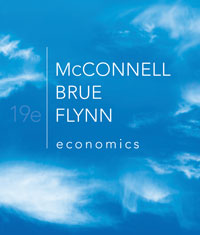Problem: While clearing debris from a house destroyed by Hurricane Katrina, a group of student helpers discovered a shoe box full of $100 bills--$30,000 in all. The students found the displaced homeowner, who promptly deposited the full amount in the local bank. Suppose the reserve requirement is 25%, and the bank was just meeting its reserve requirement prior to the deposit. - How much of this new deposit is this bank required to hold in reserve? How much does the deposit create in excess reserves?
- What is the value of the monetary multiplier?
- What is the potential increase in the money supply this new deposit can generate?
- In an attempt to increase the value of its portfolio, suppose this same bank sells $30,000 in securities to its district Federal Reserve Bank. How much excess reserves will this transaction create for the bank? By how much can the money supply potentially increase as a result of this transaction?
- Repeat parts a. through d. assuming a reserve ratio of 20%.
| Answer: - The bank is required to keep 25%, or .25 x $30,000 = $7,500. The remainder, $22,500, is excess reserves.
- With a reserve requirement of 25%, the monetary multiplier is 1/.25 = 4.
- The money supply can potentially increase by the multiplier times the initial increase in excess reserves, or 4 x $22,500 = $90,000.
- The sale to the Fed generates $30,000 in excess reserves for the bank. Its deposits have not changed as a result of the transaction, so there is no change in the amount of reserves required. The Fed simply credits the bank’s reserve account for the amount of the sale. With a money multiplier of 4, the potential increase in the money supply is 4 x $30,000 = $120,000.
- The $30,000 cash deposit would create $6,000 (= 0.2 x $30,000) in required reserves and $24,000 (= $30,000 – $6,000) in excess reserves. The money multiplier would rise to 1/0.2 = 5, and the potential increase in the money supply would be 5 x $24,000 = $120,000. The securities sale would generate $30,000 in excess reserves and potentially create 5 x $30,000 = $150,000 in new money.
|





